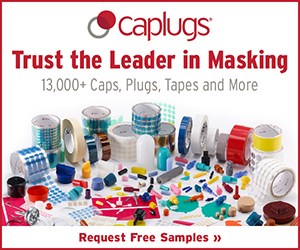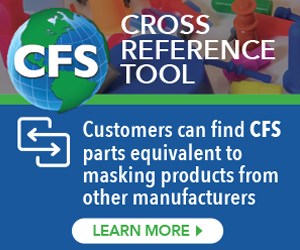Are Antimicrobial Powder Coatings a Silver Bullet?
Antimicrobial powder coatings that feature silver as a key antimicrobial ingredient are raising the powder coating industry to new heights.
The whole idea sounds like something out of a Michael Crichton novel. At first thought, the notion of using silver to fend-off bacteria seems as alien a concept as bringing back the dinosaurs, traveling through time or, well… aliens.
But the truth about silver is that its protective qualities are very real and have been prized for thousands of years, dating back as far as the Ancient Egyptians, who used it to keep their food stores free of mold and fungus, and the Phoenicians, who used silver containers to keep water from being invaded by germs. Since the 1300’s, the Catholic Church has specifically chosen silver for chalices and Eucharist trays to prevent the spread of disease between priests and parishioners. In North America, pioneers moving west put silver and copper coins in their water barrels to keep the water safe to drink. Some scholars have even argued that silver’s antimicrobial qualities may have earned the metal its role in werewolf mythology.
Today’s applications of silver may not be as exciting as the prospect of disposing of your friendly neighborhood lycanthrope, but the element has come to play a critical role in the medical world. Silver has been used in heart valve suture rings, catheters, external fixation pins, burn treatment bandages and salves and even in eye drops for newborns. Now, four years into the 21st Century, silver is playing a defining role in the powder coating industry.
How Does It Work?
A safe material for human contact, silver is a natural antimicrobial that has been shown to be effective in killing over 650 strains of bacteria, yeast, fungi and molds.
Because it is an inorganic antimicrobial, silver has been able to address many of the issues associated with its organic counterparts that have been developed over the years. These include: thermal stability, environmental compatibility, effective life expectancy and last but not least bacterial resistance.
That means that - unlike antibiotic drugs, which face a growing threat of antimicrobial resistance – silver’s antimicrobial properties stand up over the course of time.
Even if the exact mechanism for killing bacteria is not well documented, the results are “Silver kills microbes by interacting with multiple binding sites that are unlike those used by organic antibiotics,” explained Michele Potenza of Boston-based AgION Technologies Inc, “the use of silver as antimicrobial is therefore unlikely to promote antibiotic resistance.”
DuPont Powder Coatings USA works with AgION Technologes in the incorporation of AgION’s antimicrobial compound directly into its Alesta® AM line of powder coatings. The antimicrobial is a compound of elemental silver, ionically bonded to an inert and bio-compatible ceramic material, known as zeolite. The end user applies the powder just as he or she would any conventional powder coating.
Once applied, Alesta® AM’s antimicrobial properties are stable to 800° celsius and through a pH range of 3–10. Moisture in the air triggers a propriety ion exchange process by which silver is released at a controlled rate, maintaining an antimicrobial surface (see Figure 1). If humidity increases, creating a more bacteria-friendly environment, more silver is released. The compound does have a maximum release rate, so even under very wet conditions, the silver still releases slowly, insuring long term protection.
Though antimicrobial powder coatings have demonstrated an ability to stand up to the evolving nature of bacteria, one potential drawback of the coatings is that frequent washing can lower the antimicrobial life of the coating.
Antibacterial Age
In today’s “Antibacterial Age,” in which everything from hand soap to window cleaner touts antibacterial qualities, neither the popularity nor the applications of antimicrobial powder coatings is surprising. Applications for the technology include food processing equipment, building materials, storage containers and tanks, utensils and kitchen equipment, outdoor furniture, bathroom fixtures, appliances, water coolers, ice making equipment, medical equipment and fitness and playground equipment.
But if the technology–or at least the principles behind it–has been around for thousands of years, how do experts explain the recent explosion in popularity of antimicrobial powder coatings? For the answer, one need not look further than recent headlines. A year ago, the world was captivated by the SARS outbreak. In December 2003, scientists warned of a possible flu pandemic. It's natural that headlines like these would migrate into the consumer conscious.
“During our investigation of the market for an antimicrobial powder coating, we discovered a tremendous interest for these specialized products. Consumers are becoming more concerned about surfaces that may exhibit microbial growth, and prefer products that can assist in reducing this,” said Doug Bach, senior vice president of marketing and business development–Americas of DuPont Powder Coatings USA. “There may also be a cosmetic benefit resulting from this technology, since the growth of unsightly mildew and mold may be reduced on such things as patio furniture used in warm, humid climates.”
Future Applications
Though it would be unwise to “coat our entire world with antimicrobial substances,” warns Marjorie Kelly Cowan, Ph.D., professor of microbiology at Miami University in Middletown, OH, the technology does hold tremendous promise, especially in hospitals and medical facilities.
Antimicrobial powder coatings are currently in use at the new City of Hope’s Helford Clinical Research Hospital in Duarte, CA, on ductwork, door handles and hardware and push plates. Other hospitals and clinics are looking into using antimicrobial powder coated materials in emergency rooms, surgery areas and patient rooms, on cabinets, counters and other surfaces.
At Montgomery, Illinois-based Lyon Workspace Products—a supplier of steel shelving, lockers, storage cabinets, ergonomic workspace products and pallet racks—antimicrobial powder coatings are being used to coat lockers for schools and public facilities. The company has become so enamored with antimicrobial coatings, it prominently features the technology on its web site.
“It has definitely been a selling point [for Lyon],” said Matt Washington, vice president of manufacturing for Lyon. “The last couple of jobs we’ve gotten have been because of [antimicrobial powder coatings]. We first started using it on lockers. But since then we’ve had a couple of people come forward and say, ‘this is something we’ve been wanting for a while, can you make it for us?’”
In addition to consumer-demand, another aspect of the appeal of antimicrobial powder coating technology is that it did not require the company to purchase new capital equipment. “We had to make no changes [in order to implement the antimicrobial powder coatings], which is why we like this all the more,” said Mr. Washington. “It sprays the same as any other powder.”
According to Greg Bocchi, executive director of The Powder Coating Institute, the emergence of antimicrobial powder coatings represents a juncture of powder coatings with several key industries. “With germ resistance even more critical these days, this could become quite a breakthrough for not only the powder coating industry, but also for the medical industry, food service industry and others.”
Related Content
The Powder Coating Process
Powder coating is one of the most durable finishes that can be applied to industrial manufactured products, and offers excellent corrosion protection and is very safe because of its lack of volatile organic compounds. To understand the powder coating process you should start with the fundamentals.
Read MoreProducts Finishing Reveals 2023 Qualifying Top Shops
Each year PF conducts its Top Shops Benchmarking Survey, offering shops a tool to better understand their overall performance in the industry. The program also recognizes shops that meet a set of criteria to qualify as Top Shops.
Read MoreCoating Systems with the Best Long-Term Performance
The best protection against corrosion and UV exposure, says Axalta’s Mike Withers, is electrocoat and a super durable powder coating.
Read MoreTouch-up Options for Powder Coated Parts
Is it true that powder coating cannot be touched up? Powder coating expert Rodger Talbert offers options for powder coating touch-ups.
Read MoreRead Next
Episode 42: An Interview with Robin Deal, Hubbard-Hall
Hubbard-Hall wastewater treatment specialist Robin Deal discusses the latest trends in wastewater management.
Read MorePowder Coating 4.0: Smarter, Faster, More Efficient and Connected
New tools reduce cost and waste, lower manufacturing footprint of powder coating operations.
Read MoreThe 2024 Ford Mustang: All the Colors Available
Although Chevrolet has announced the end of the Camaro and Dodge is offering “Last Call” editions of the Charger and Challenger, the Ford Mustang is launching to its seventh generation.
Read More

































